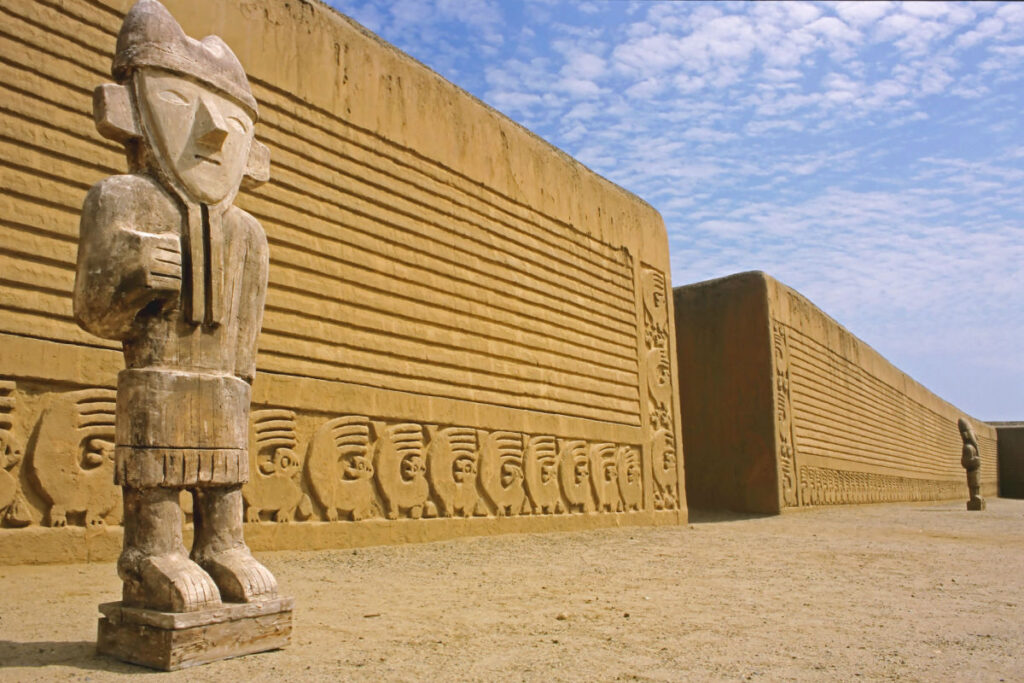No products in the cart.
Travel Guide
Travelers Should Visit These 10 World Heritage Sites Before It Is Too Late
Last Updated
Imagine a world with no Yellowstone National Park, Stonehenge, Machu Picchu, or Egypt’s Pyramids. While it is easy to take some of these destinations for granted, their survival is not guaranteed. Luckily, the United Nations Educational, Scientific, and Cultural Organization, better known as UNESCO, works to identify, protect, and preserve cultural and natural heritage around the world.

What A UNESCO Designation Means
The idea behind UNESCO is to promote peace and security by increasing intercultural education and understanding of our shared world heritage. In an attempt to safeguard our world heritage for ourselves and for future generations, UNESCO designates certain sites of cultural and natural importance to its World Heritage List. Ideally, sites on the list receive special protection through their recognition, but that is not always the case.

UNESCO World Heritage In Danger
In addition to maintaining the World Heritage List, UNESCO also identifies sites that are in danger. Development, conflict, and natural disasters are all reasons why a World Heritage Site could be in danger. Just this week, UNESCO placed three new sites on the list of World Heritage In Danger.
The Ukranian Port City of Odessa, the Landmarks of the Ancient Kingdom of Saba in Yemen, and the Rachid Karameh International Fair of Tripoli in Lebanon were all simultaneously given UNESCO status and placed on the World Heritage In Danger list. If urgent action is not taken, these important sites could be damaged or lost forever.

Some of the sites on the World Heritage in Danger list are currently not safe for tourists to visit because of political conflict. However, many of the sites are accessible and can be rewarding destinations to visit. We’ve included some of each in hopes that political conflicts will give way to peace so that we can explore all the beautiful sites the world has to offer.
Below is our list of the top 5 Cultural and top 5 Natural World Heritage Sites in Danger to visit before it is too late.
Top 5 Cultural World Heritage Sites In Danger
Historic Center Of Vienna, Austria
- What is it: Vienna’s historic center has been an important location for centuries. Notably, Vienna played an important role in musical history and is home to significant Baroque castles and other architectural gems.
- Why is it in danger: The integrity of Vienna’s Historic Center has been under threat since 2017 because of the development of the close proximity of high-rise buildings and development.
- How to visit: Vienna is best explored on foot, and when visitors are in need of a break, the top things to do are enjoy coffee and people watching at a cafe or listening to some live music at one of the many concert halls.
Top 5 Travel Insurance Plans For 2023 Starting At $10 Per Week

The Old City Of Jerusalem And Its Walls
- What is it: Jerusalem is a renowned historical and holy city for Judaism, Christianity, and Islam. The city contains 220 historic monuments, including the Wailing Wall, which is considered to be the most important religious site in the world for Jewish people.
- Why is it in danger: Jerusalem was placed on the list in 1982 because of deliberate destruction and remains on the list today because of other threats, including deterioration and the impact of archaeological excavations.
- How to visit: The Wailing Wall, also referred to as the Western Wall, is a Jewish site of importance, but even non-Jews will find it to be a spiritual experience. Just be sure to follow all directions and be respectful. Men will need to wear a yarmulke (available on-site if you don’t have one), and women need to cover their legs and shoulders. There are separate areas for men and women to visit, so be sure to follow the signs.

Chan Chan Archaeological Zone, Peru
- What is it: Chan Chan was the capital of the Chimu Kingdom which peaked in the 15th century before ultimately falling to the Incas. It was the largest city in pre-Columbian America.
- Why is it in danger: Chan Chan is under threat of loss because of the high rate of deterioration due to a lack of conservation and maintenance.
- How to visit: Be sure to stop at the site’s museum to see how people lived at Chan Chan. The archaeological site is extensive and exposed to the elements – so bring sunscreen, a hat, and water if you plan on exploring.

Cultural Landscape And Archaeological Remains Of The Bamiyan Valley, Afghanistan
- What is it: The Bamiyan Valley’s eight archaeological sites include ancient Buddhist monasteries carved into cliffs, cave art, and giant Buddha statues. For many centuries, the Bamiyan Valley was an important Buddhist pilgrimage site.
- Why is it in danger: The Bamiyan Valley suffered great losses in 2001 when Taliban bombings deliberately destroyed two giant Buddha statues.
- How to visit: Even though the Buddha statues have been destroyed, the site is still worth a visit. However, given Afghanistan’s current political climate, now is not a safe time to visit.

Timbuktu, Mali
- What is it: Timbuktu dates back to the 5th century and became an important hub of Islamic education in the 15th and 16th centuries. Today three earthen mosques remain along with 16 mausoleums and are terrific examples of traditional earthen architecture and building techniques.
- Why is it in danger: Timbuktu was originally placed on the list because of development and desertification. The site remains in danger because of the ongoing war in Mali and the occupation and intentional destruction of heritage sites by armed groups.
- How to visit: Timbuktu is not a safe destination to visit due to war and terrorist attacks.

Top 5 Natural World Heritage Sites In Danger
Tropical Rainforest Of Sumatra, Indonesia
- What is it: Three national parks make up the Tropical Rainforests site on the Indonesian island of Sumatra. The rainforests have an incredible amount of biodiversity and are home to Sumatran orangutans, tigers, and rhinos, as well as over 10,000 species of plants and the highest volcano in Indonesia.
- Why is it in danger: The rainforests were listed in 2011 because of rampant poaching, illegal logging, and planned infrastructure development in the area.
- How to visit: Animal and nature lovers who want to view wildlife in their natural habitat should hire a local guide for the best chance at finding some. Guided treks are also a great way to learn about the nature, culture, and people of Sumatra.

Islands And Protected Areas Of The Gulf Of California, Mexico
- What is it: With 244 islands, islets, coastal areas, and 39% of the world’s marine mammal species, the Gulf of California’s protected areas are a hub for oceanographic study and have been referred to as the “Aquarium of the World.”
- Why is it in danger: Illegal and unsustainable fishing practices have placed marine life under threat.
- How to visit: The Gulf of California is a large area to explore. Divers who want to have a glimpse of the incredible marine life can use areas like Los Cabos as a base for a diving adventure.

Everglades National Park, Florida
- What is it: The Florida Everglades is a unique wetland ecosystem that includes mangrove forests, marshes, and seagrass. It is home to alligators, manatees, and panthers, as well as a large number of bird species, some of which are endangered.
- Why is it in danger: The Everglades are considered to be in danger because of the threat of storms, pollution, invasive species, and urban developments.
- How to visit: The park has loads of paddling trails where visitors can canoe or kayak through the mangroves. Experienced paddlers can bring their own boat or rent one, while novices might feel more comfortable taking a guided tour.

Selous Game Reserve, Tanzania
- What is it: Tanzania’s incredible Selous Game Reserve is one of the largest protected areas in Africa. It is home to elephants, rhinos, cheetahs, giraffes, and hippos, to name a few.
- Why is it in danger: The biggest threat to the game reserve is illegal poaching, and it has had a devastating effect on the population of the park’s wildlife. Additional threats come from nearby uranium mines, logging, and the proposed construction of a dam.
- How to visit: The best way to explore Selous is to hire a local guide to take you on a Jeep tour. The guides know the park and its animals well and provide the best chance of seeing wildlife up close.

Rainforests of the Atsinanana, Madagascar
- What is it: The six national parks that make up the Rainforests of the Atsinanana are home to some truly unique plants and animals, all of which depend on the health of the ecosystem for their survival.
- Why is it in danger: Wildfires are a huge risk to the health of the rainforests. There are also problems with poaching, mining, and illegal logging.
- How to visit: If you are traveling to Madagascar to see the beautiful rainforests make sure you give yourself enough time. The parks are enormous, and there is so much to see. It is best to hire a guide and do a multi-day trek.

Traveler Alert: Don’t Forget Travel Insurance For Your Next Trip!
↓ Join Our Community ↓
The Travel Off Path Community FB group has all the latest reopening news, conversations, and Q&A’s happening daily!

SUBSCRIBE TO OUR LATEST POSTS
Enter your email address to subscribe to Travel Off Path’s latest breaking travel news, straight to your inbox
This article originally appeared on TravelOffPath.com
Source link

